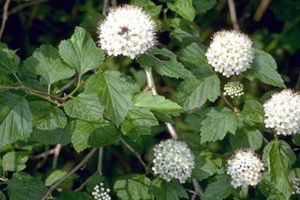Physocarpus
| Physocarpus | ||||||||||||
|---|---|---|---|---|---|---|---|---|---|---|---|---|

Physocarpus opulifolius |
||||||||||||
| Systematics | ||||||||||||
|
||||||||||||
| Scientific name | ||||||||||||
| Physocarpus | ||||||||||||
| ( Cambess. ) Raf. |
Physocarpus is a plant kind from the family of the rose family (Rosaceae).
description
Physocarpus are non-prickly, deciduous shrubs , the bark of which peels off in thin strips. Their leaves are alternate and are triple lobed, the ungrown stipules decay early.
The inflorescence is a terminal, rounded to pseudo- cluster- shaped cluster . The flowers are hermaphroditic and five-fold. The flower cup is bell-shaped and open at the top, an outer calyx is missing, a disc is not recognizable. The sepals adjoin each other, but do not overlap, the petals are white. The stamens are numerous. There are two to five pistils fused together at the base and two to four ovules .
The fruit is a short-stalked, bloated, large pelvic fruit that protrudes from the flower cup, the fruits open along the seams. The few seeds have a shiny, hard outer skin.
distribution
The genus is found almost entirely in North America with the exception of Physocarpus amurensis in Northeast Asia. It usually grows on river banks or similarly moist locations.
The snowball-leaved bladder sparrow ( Physocarpus opulifolius ) is a widespread ornamental shrub in Europe and is increasingly emerging as a garden refugee .
Systematics
The genus was first described in 1824 by Jacques Cambessèdes as a section of the Spiraea and established as a separate genus in 1838 by Constantine Samuel Rafinesque . It is classified in the tribe Neillieae of the subfamily Spiraeoideae . There are around ten types, including:
- Physocarpus alternans (MEJones) JTHowell
- Physocarpus amurensis (Maxim.) Maxim. : It occurs in China, Northern Korea and Far Eastern Asian Russia.
- Physocarpus bracteatus (Rydb.) Rehder : It occurs in Colorado .
- Physocarpus capitatus (Pursh) Kuntze : It occurs in Alaska , British Columbia , Washington , Oregon , Idaho and California .
- Physocarpus glabratus (Rydb.) Rehder
- Physocarpus malvaceus (Greene) Kuntze : It occurs in western Canada and the western United States.
- Physocarpus monogynus (Torr.) JMCoult.
- Snowball-leaved bladder spar ( Physocarpus opulifolius (L.) Maxim. )
literature
- C. Kalkman: Rosaceae. In: Klaus Kubitzki (Ed.): The Families and Genera of Vascular Plants - Volume VI - Flowering Plants - Dicotyledons - Celastrales, Oxalidales, Rosales, Cornales, Ericales , 2004, p. 359, ISBN 978-3-540-06512- 8th
Individual evidence
- ↑ Global Compendium of Weeds: Physocarpus opulifolius (Rosaceae). http://www.hear.org/gcw/species/physocarpus_opulifolius/
- ↑ a b c d Physocarpus in the Germplasm Resources Information Network (GRIN), USDA , ARS , National Genetic Resources Program. National Germplasm Resources Laboratory, Beltsville, Maryland. Retrieved April 20, 2017.
Web links
Physocarpus opulifolius at Floraweb.de http://www.floraweb.de/ Pflanzenarten/artenhome.xsql?suchnr=4234&